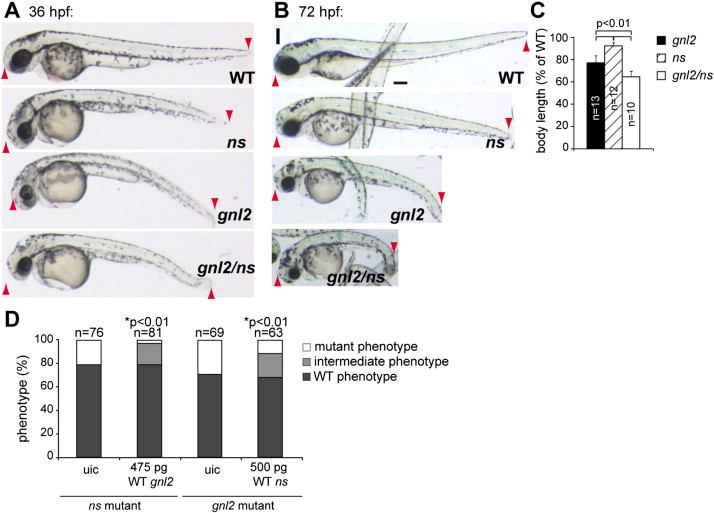Fig. S2
Gnl2 and NS have (partially) redundant functions. Phenotypes of WT, ns, gnl2 and gnl2/ns compound mutants at 36 (A) and 72 (B) hpf. At 36 hpf, gnl2/ns compound mutants (bottom panel in A) show enhanced reduction of the brain, eye and whole body length (red arrowheads in A) and enhanced hyperinflation of the hindbrain ventricle as compared to the single gnl2 and ns mutants. (B) At 72 hpf, the total length of the compound mutant body (red arrowheads) is dramatically reduced as compared to the slight reduction of ns and moderate reduction of gnl2 total embryo length. Furthermore, the head and eye size reduction is enhanced in compound mutants, indicating synergistic phenotypes. (C) Quantification of whole body length as % of WT body length. Statistics: Student′s t-test with p-values indicated in the graph. Error bars represent SD. Images are lateral view, anterior to the left and dorsal up. (D) Injection of 475 pg WT gnl2 mRNA and 500 pg WT ns mRNA results in partial rescue of the ns-/- and gnl2-/- phenotypes, respectively, as characterized by the increased size of the total embryo, head and eyes as compared to uninjected controls (uic). The number of embryos injected is indicated above the bars. Statistics: two-tailed Fisher′s exact probability test for a table of frequency data with p-values indicated above the bar. Scalebar 250 μm.
Reprinted from Developmental Biology, 355(2), Paridaen, J.T., Janson, E., Utami, K.H., Pereboom, T.C., Essers, P.B., van Rooijen, C., Zivkovic, D., and Macinnes, A.W., The nucleolar GTP-binding proteins Gnl2 and nucleostemin are required for retinal neurogenesis in developing zebrafish, 286-301, Copyright (2011) with permission from Elsevier. Full text @ Dev. Biol.

